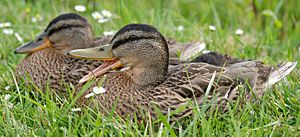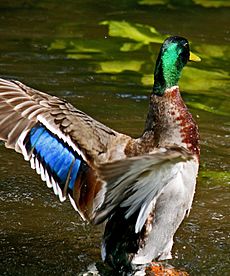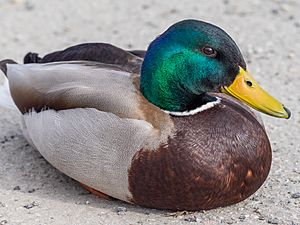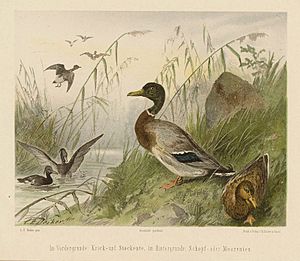Mallard facts for kids
Quick facts for kids Mallard |
|
|---|---|
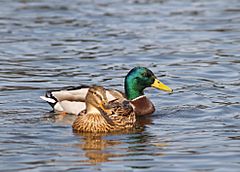 |
|
| Mallard female (front) and male (rear) | |
| Conservation status | |
| Scientific classification | |
| Kingdom: | |
| Phylum: | |
| Class: | |
| Order: | |
| Family: | |
| Subfamily: | |
| Genus: |
Anas
|
| Species: |
A. platyrhynchos
|
| Binomial name | |
| Anas platyrhynchos |
|
The Mallard (Anas platyrhynchos) is the best-known and most recognizable of all ducks. It can be found throughout most of North America, Europe, Asia, New Zealand and Australia. It is the most common and widespread duck. It can be found in almost any area with a wetland habitat, even in urban areas.
Contents
Description
The mallard is a medium-sized waterfowl species that is often slightly heavier than most other dabbling ducks. It is 50–65 cm (20–26 in) long – of which the body makes up around two-thirds – has a wingspan of 81–98 cm (32–39 in), and weighs 0.72–1.58 kg (1.6–3.5 lb). Among standard measurements, the wing chord is 25.7 to 30.6 cm (10.1 to 12.0 in), the bill is 4.4 to 6.1 cm (1.7 to 2.4 in), and the tarsus is 4.1 to 4.8 cm (1.6 to 1.9 in).
The breeding male mallard is unmistakable, with a glossy bottle-green head and a white collar that demarcates the head from the purple-tinged brown breast, grey-brown wings, and a pale grey belly. The rear of the male is black, with white-bordered dark tail feathers. The bill of the male is a yellowish-orange tipped with black, with that of the female generally darker and ranging from black to mottled orange and brown. The female mallard is predominantly mottled, with each individual feather showing sharp contrast from buff to very dark brown, a coloration shared by most female dabbling ducks, and has buff cheeks, eyebrow, throat, and neck, with a darker crown and eye-stripe.
Both male and female mallards have distinct iridescent purple-blue speculum feathers edged with white, which are prominent in flight or at rest but temporarily shed during the annual summer moult. Upon hatching, the plumage of the duckling is yellow on the underside and face (with streaks by the eyes) and black on the back (with some yellow spots) all the way to the top and back of the head. Its legs and bill are also black. As it nears a month in age, the duckling's plumage starts becoming drab, looking more like the female, though more streaked, and its legs lose their dark grey colouring. Two months after hatching, the fledgling period has ended, and the duckling is now a juvenile. Between three and four months of age, the juvenile can finally begin flying, as its wings are fully developed for flight (which can be confirmed by the sight of purple speculum feathers). Its bill soon loses its dark grey colouring, and its sex can finally be distinguished visually by three factors: 1) the bill is yellow in males, but black and orange in females; the breast feathers are reddish-brown in males, but brown in females; and 3) in males, the centre tail feather (drake feather) is curled, but in females, the centre tail feather is straight. During the final period of maturity leading up to adulthood (6–10 months of age), the plumage of female juveniles remains the same while the plumage of male juveniles gradually changes to its characteristic colours. This change in plumage also applies to adult mallard males when they transition in and out of their non-breeding eclipse plumage at the beginning and the end of the summer moulting period. The adulthood age for mallards is fourteen months, and the average life expectancy is three years, but they can live to twenty.
Several species of duck have brown-plumaged females that can be confused with the female mallard. The female gadwall (A. strepera) has an orange-lined bill, white belly, black and white speculum that is seen as a white square on the wings in flight, and is a smaller bird. More similar to the female mallard in North America are the American black duck (A. rubripes), which is notably darker-hued in both sexes than the mallard, and the mottled duck (A. fulvigula), which is somewhat darker than the female mallard, and with slightly different bare-part colouration and no white edge on the speculum.
In captivity, domestic ducks come in wild-type plumages, white, and other colours. Most of these colour variants are also known in domestic mallards not bred as livestock, but kept as pets, aviary birds, etc., where they are rare but increasing in availability.
A noisy species, the female has the deep quack stereotypically associated with ducks. Male mallards make a sound phonetically similar to that of the female, a typical quack, but it is a deep and raspy and can also sound like breeeeze. When incubating a nest, or when offspring are present, females vocalise differently, making a call that sounds like a truncated version of the usual quack. They hiss if the nest or offspring are threatened or interfered with. When taking off, the wings of a mallard produce a characteristic faint whistling noise.
Distribution and habitat
The mallard is widely distributed across the Northern and Southern Hemispheres; in North America its range extends from southern and central Alaska to Mexico, the Hawaiian Islands, across Eurasia, from Iceland and southern Greenland and parts of Morocco (North Africa) in the west, Scandinavia and Britain to the north, and to Siberia, Japan, and South Korea, in the east, south-eastern and south-western Australia and New Zealand in the Southern hemisphere. It is strongly migratory in the northern parts of its breeding range, and winters farther south. For example, in North America, it winters south to the southern United States and northern Mexico, but also regularly strays into Central America and the Caribbean between September and May.
The mallard inhabits a wide range of habitats and climates, from Arctic tundra to subtropical regions. It is found in both fresh- and salt-water wetlands, including parks, small ponds, rivers, lakes and estuaries, as well as shallow inlets and open sea within sight of the coastline. Water depths of less than 0.9 metres (3.0 ft) are preferred, with birds avoiding areas more than a few metres deep. They are attracted to bodies of water with aquatic vegetation.
Behaviour
Feeding
The mallard is omnivorous and very flexible in its choice of food. Its diet may vary based on several factors, including the stage of the breeding cycle, short-term variations in available food, nutrient availability, and interspecific and intraspecific competition. The majority of the mallard's diet seems to be made up of gastropods, invertebrates (including beetles, flies, lepidopterans, dragonflies, and caddisflies), crustaceans, worms, many varieties of seeds and plant matter, and roots and tubers. During the breeding season, male birds were recorded to have eaten 37.6% animal matter and 62.4% plant matter, most notably Echinochloa crus-galli, and nonlaying females ate 37.0% animal matter and 63.0% plant matter, while laying females ate 71.9% animal matter and only 28.1% plant matter. Plants generally make up the larger part of a bird's diet, especially during autumn migration and in the winter.
The mallard usually feeds by dabbling for plant food or grazing; there are reports of it eating frogs. However, in 2017 a flock of mallards in Romania were observed hunting small migratory birds, including grey wagtail and black redstart, the first documented occasion they had been seen attacking and consuming large vertebrates. It usually nests on a river bank, but not always near water. It is highly gregarious outside of the breeding season and forms large flocks, which are known as sords.
Breeding
Mallards usually form pairs (in October and November in the Northern Hemisphere) until the female lays eggs at the start of the nesting season, which is around the beginning of spring.
Egg clutches number 8–13 creamy white to greenish-buff eggs free of speckles. They measure about 58 mm (2.3 in) in length and 32 mm (1.3 in) in width. The eggs are laid on alternate days, and incubation begins when the clutch is almost complete. Incubation takes 27–28 days and fledging takes 50–60 days. The ducklings are precocial and fully capable of swimming as soon as they hatch. However, filial imprinting compels them to instinctively stay near the mother, not only for warmth and protection but also to learn about and remember their habitat as well as how and where to forage for food. When ducklings mature into flight-capable juveniles, they learn about and remember their traditional migratory routes (unless they are born and raised in captivity).
During the breeding season, both male and female mallards can become aggressive, driving off competitors to themselves or their mate by charging at them. Males tend to fight more than females, and attack each other by repeatedly pecking at their rival's chest, ripping out feathers and even skin on rare occasions.
Predators and threats
Mallards of all ages (but especially young ones) and in all locations must contend with a wide diversity of predators including raptors, mustelids, corvids, snakes, raccoons, opossums, skunks, turtles, large fish, felids, and canids, including domesticated ones. The most prolific natural predators of adult mallards are red foxes (which most often pick off brooding females) and the faster or larger birds of prey, i.e. peregrine falcons, Aquila eagles, or Haliaeetus eagles. In North America, adult mallards face no fewer than 15 species of birds of prey, from northern harriers and short-eared owls (both smaller than a mallard) to huge bald and golden eagles, and about a dozen species of mammalian predator, not counting several more avian and mammalian predators who threaten eggs and nestlings.
Mallards are also preyed upon by other waterside apex predators, such as the grey heron, European herring gull, the wels catfish, and the northern pike. Crows (Corvus spp.) are also known to kill ducklings and adults on occasion. Also, mallards may be attacked by larger anseriformes such as swans (Cygnus spp.) and geese during the breeding season, and are frequently driven off by these birds over territorial disputes. Mute swans (Cygnus olor) have been known to attack or even kill mallards if they feel that the ducks pose a threat to their offspring.
The predation-avoidance behavior of sleeping with one eye open, allowing one brain hemisphere to remain aware while the other half sleeps, was first demonstrated in mallards, although it is believed to be widespread among birds in general.
Status and conservation
Since 1998, the mallard has been rated as a species of least concern on the IUCN Red List of Endangered Species. This is because it has a large range–more than 20,000,000 km2 (7,700,000 mi2)–and because its population is increasing, rather than declining by 30% over ten years or three generations and thus is not warranted a vulnerable rating. Also, the population size of the mallard is very large.
Unlike many waterfowl, mallards have benefited from human alterations to the world – so much so that they are now considered an invasive species in some regions. They are a common sight in urban parks, lakes, ponds, and other man-made water features in the regions they inhabit, and are often tolerated or encouraged in human habitat due to their placid nature towards humans and their beautiful and iridescent colours. While most are not domesticated, mallards are so successful at coexisting in human regions that the main conservation risk they pose comes from the loss of genetic diversity among a region's traditional ducks once humans and mallards colonise an area. Mallards are very adaptable, being able to live and even thrive in urban areas which may have supported more localised, sensitive species of waterfowl before development.
Invasiveness
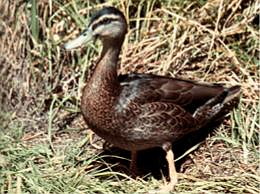
Mallards are causing severe "genetic pollution" to South Africa's biodiversity by breeding with endemic ducks even though the Agreement on the Conservation of African-Eurasian Migratory Waterbirds – an agreement to protect the local waterfowl populations – applies to the mallard as well as other ducks. The hybrids of mallards and the yellow-billed duck are fertile, capable of producing hybrid offspring. If this continues, only hybrids occur and in the long term result in the extinction of various indigenous waterfowl. The mallard duck can cross breed with 63 other species, posing a severe threat to indigenous waterfowl's genetic integrity. Mallards and their hybrids compete with indigenous birds for resources, including nest sites, roosting sites, and food.
Availability of mallards, mallard ducklings, and fertilised mallard eggs for public sale and private ownership, either as livestock or as pets, is currently legal in the United States except for the state of Florida, which has currently banned domestic ownership of mallards. This is to prevent hybridisation with the native mottled duck.
The mallard is considered an invasive species in New Zealand, where it competes with the local New Zealand grey duck, which was overhunted in the past. There, and elsewhere, mallards are spreading with increasing urbanisation and hybridising with local relatives.
The Eastern or Chinese spot-billed duck is currently introgressing into the mallard populations of the Primorsky Krai, possibly due to habitat changes from global warming. The Mariana mallard was a resident allopatric population – in most respects a good species – apparently initially derived from mallard-Pacific black duck hybrids; unfortunately, it became extinct in the late 20th century.
The Laysan duck is an insular relative of the mallard, with a very small and fluctuating population. Mallards sometimes arrive on its island home during migration, and can be expected to occasionally have remained and hybridised with Laysan ducks as long as these species have existed. However, these hybrids are less well adapted to the peculiar ecological conditions of Laysan Island than the local ducks, and thus have lower fitness. These ducks were found throughout the Hawaiian archipelago before 400 AD, after which they suffered a rapid decline during the Polynesian colonisation. Now, their range includes only Laysan Island. It is one of the successfully translocated birds, after having become nearly extinct in the early 20th century.
Relationship with humans
Domestication
Mallard have often been ubiquitous in their regions among the ponds, rivers, and streams of human parks, farms, and other man-made waterways – even to the point of visiting water features in human courtyards.
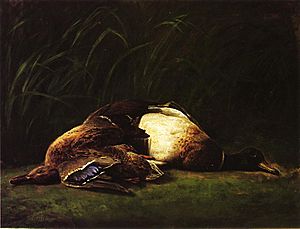
Mallard have had a long relationship with humans. Almost all domestic duck breeds derive from the mallard, with the exception of a few Muscovy breeds. Mallards are generally monogamous while domestic ducks are mostly polygamous. Domestic ducks have no territorial behaviour and are less aggressive than mallards. Domestic ducks are mostly kept for meat, as their eggs have a strong flavor. They were first domesticated in Southeast Asia at least 4000 years ago, during the Neolithic Age, and were also farmed by the Romans in Europe, and the Malays in Asia. It is also common for mallards to mate with domestic ducks and produce hybrid offspring that are fully fertile. Due to this, mallards have been found to be contaminated with the genes of the domestic duck.
Hunting
Mallards are one of the most common varieties of ducks hunted as a sport. The ideal location for hunting mallards is considered to be where the water level is somewhat shallow. Hunting mallards might cause the population to decline in some places, at some times, and with some populations. In certain countries, the mallard may be legally shot but is protected under national acts and policies. For example, in the United Kingdom, the mallard is protected under the Wildlife and Countryside Act 1981, which restricts certain hunting methods or taking or killing mallards.
As food
Since ancient times, the mallard has been eaten as food. The wild mallard was eaten in Neolithic Greece. Usually, only the breast and thigh meat is eaten. It does not need to be hung before preparation, and is often braised or roasted, sometimes flavoured with bitter orange or with port.
Images for kids
-
An American black duck (upper left) and a male mallard (lower right) in eclipse plumage
-
A male mute swan (Cygnus olor) driving off a female mallard
See also
 In Spanish: Ánade real para niños
In Spanish: Ánade real para niños



